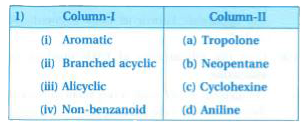Which are the functional group in the following? Write its name, suffixe and prefix
(a) CH3CH2CH2COOH (b) CH3CH2CH2COO−Na+ (c ) CH3CH2COOCH3 (d) CH3CH2CH2COCl (e ) CH3CH2CH2CONH2 (f ) CH3CH2CH2CHO
Topper's Solved these Questions
- ORGANIC CHEMISTRY SOME BASIC PRINCIPLES AND TECHNIQUESBook:KUMAR PRAKASHANChapter:ORGANIC CHEMISTRY SOME BASIC PRINCIPLES AND TECHNIQUESExercise:Section-B - Match the following
Explore 28 Videos
- ORGANIC CHEMISTRY SOME BASIC PRINCIPLES AND TECHNIQUESBook:KUMAR PRAKASHANChapter:ORGANIC CHEMISTRY SOME BASIC PRINCIPLES AND TECHNIQUESExercise:Section-B - State True or False For The Following Statements
Explore 42 Videos
- ORGANIC CHEMISTRY SOME BASIC PRINCIPLES AND TECHNIQUESBook:KUMAR PRAKASHANChapter:ORGANIC CHEMISTRY SOME BASIC PRINCIPLES AND TECHNIQUESExercise:Section A -Try Your Self-3
Explore 20 Videos
- HYDROGENBook:KUMAR PRAKASHANChapter:HYDROGENExercise:Section-D NCERT Exemplar (Long Answer)
Explore 8 Videos
- QUESTION ASKED IN JEE -2018Book:KUMAR PRAKASHANChapter:QUESTION ASKED IN JEE -2018Exercise:MCQ
Explore 10 Videos
Similar Questions
Match column-I and column-II with correct relation.

View Solution(i) Organic compound is first synthesised by F. Wohier
(ii) Berzeiius stated that some mysterious force existing in the living organism.
(iii) In 1882 Wohler prepared organic compound from inorganic compound at that time vital force they accepted.
(iv) Kolbe prepared methane and Berthelot prepared acetic acid
View Solution38cm2N2 gas at 300K temperature and 96pa pressure. In 0.25g organic compound calculate the % of nitrogen. (1 atm .- 101.3 pa)
View SolutionAtomic hydrogen combines with almost all elements but molecular hydrogen does not. Explain.
View SolutionAccording to molecular orbital theory, which of the following will not be a viable molecule?
View SolutionName the functional groups present in the following compounds. (a) CH_(3)COCH_(2)CH_(2)CH_(2)CH_(3) , (b) CH_(3)CH_(2)CH_(2)COOH (c ) CH_(3)CH_(2)CH_(2)CH_(2)CHO , (d) CH_(3)CH_(2)OH
View SolutionWrite the common name of the following alkyl groups.

(c)−CH3∣C∣CH3−CH3
(d)−CH2−CH3 , (e)CH3−CH2−CH2−
View SolutionCH_(3)CH_(2)CH(CHO)CH_(2)CH_(3) and CH_(3)CH(CHO) CH_(2)CH_(2)CH_(3) are :-
View SolutionName the functional groups present in the following compounds: (i) CH_(3)-CH_(2)-CH_(2)-OH (ii) CH_(3)-CH_(2)-CH_(2)-COOH (iii) CH_(3)-CH_(2)-CHO (iv) CH_(3)-CO-CH_(2)-CH_(3)
View Solutionनिम्नलिखित यौगिक का सही नाम है -
CH3 |CH3CH2−C=CH−CH−CH2−CH3 |CH3CH2−CH−CH2−CH2−CH3
View Solutionनिम्न यौगिकों में विद्ममान अभिलक्ष्कीय (क्रियात्मक) समूहों के नाम लिखिए- (i)CH3CH2CH2OH(ii)CH3CH2CH2COOH(iii)CH3−CH2−CHO(iv)CH3COCH2CH2CH3
View Solutionwrite the IUPAC name {:(CH_(3)CH_(2)CH_(2)CH_(2)" "CH_(2)CH_(3)" "CH_(3)),(" | | |"),(" "CH_(3)-CH-C=CH-CH_(2)-CH-CH_(3)):}
View SolutionName the functional groups present in the following compounds:
(a)CH3COCH2CH2CH2CH3 (b)CH3CH2CH2COOH
(c)CH3CH2CH2CH2CHO (d)CH3CH2OH
View SolutionName the functional groups present in the following compounds. (a) CH_(3)COCH_(2)CH_(2)CH_(2)CH_(3) , (b) CH_(3)CH_(2)CH_(2)COOH (c ) CH_(3)CH_(2)CH_(2)CH_(2)CHO , (d) CH_(3)CH_(2)OH
View SolutionArrange the following in the order of increasing boiling points.
CH3CH2CHO(A),CH3CH2CH2CH2OH(B),
CH3CH2OCH2CH3(C),CH3CH2CH2CH3(D).
View Solution


